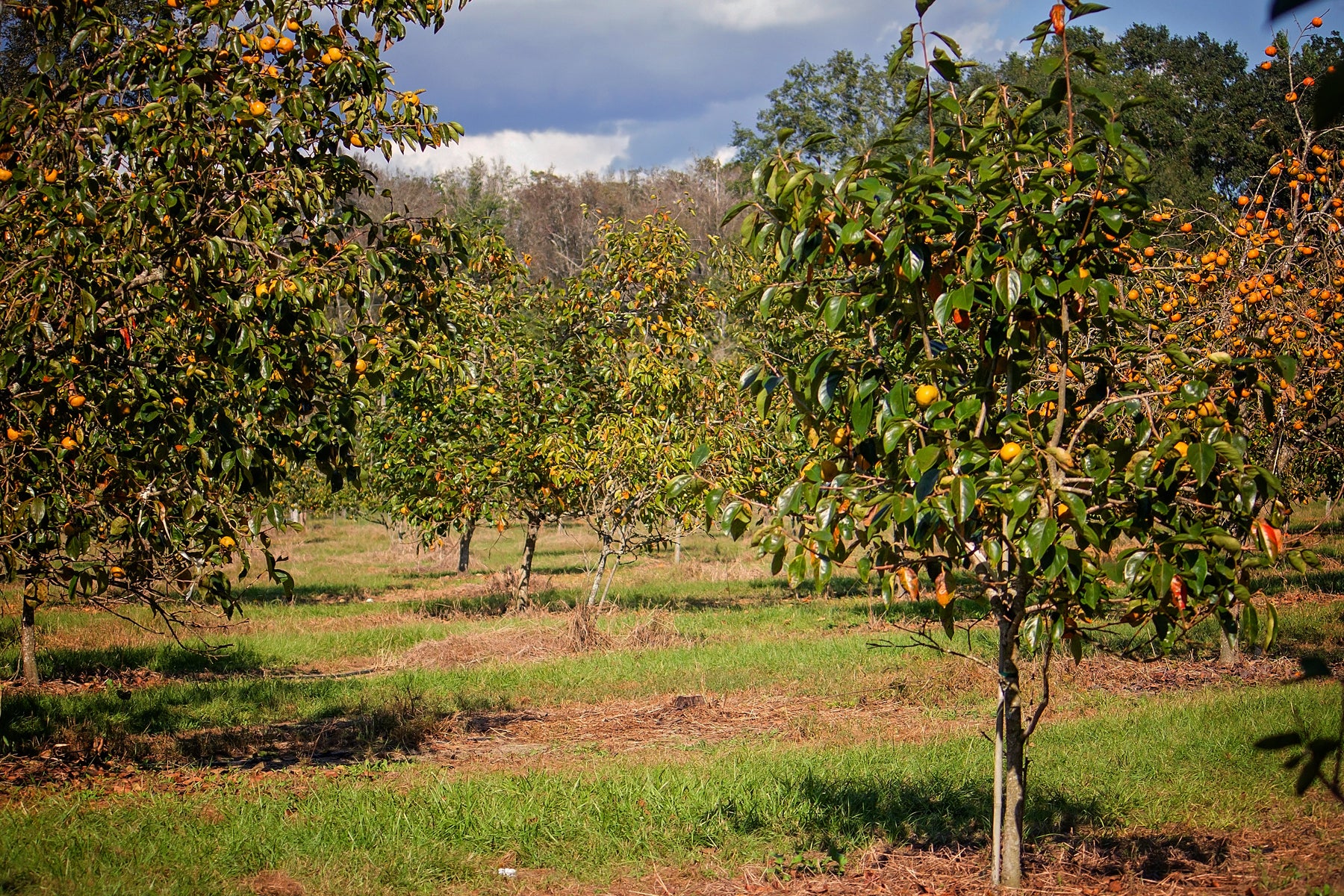Persimmons tend to be a warmer climate fruit tree, but we do have a few varieties that will work in colder regions such as USDA Zone 6. Around our nursery, we call the persimmon tree a diva. She doesn't like any of her growing conditions to change, so being put in a box for a few days tends to upset her. But once you get past the transplant hurdle, the persimmon tree is a fantastic addition to your yard and you can harvest your first crop in as little as 4 years.
Persimmons are great trees for the home gardener, and they are easy to plant. First, dig a hole wider than it is deep. The crown should sit a tad above the soil line to accommodate settling. Backfill the soil to create a pyramid in the center of the hole. Set the tree on top, and add enough dirt to fill the hole. We also recommend adding DieHard™ Transplant to the planting hole for quicker root establishment and less risk of transplant shock.
Persimmons are successfully grown in deep, well-drained, slightly acidic soil. A location that receives full sun is ideal for the tree although partial shade may be tolerated. They also have a strong taproot, so it requires a deeper planting hole than most trees. Staking trees when young also helps keep a straight form. Don’t be alarmed at the color of the roots. They naturally appear black and should not be considered diseased or dead. And lastly, keep a 3 foot radius around the base of the tree free of weeds and/or established lawn. Weeds and grass deprive your young tree of water and nutrients that are essential in establishing your new persimmon tree.
You Can Grow Persimmons in a Container
Persimmon trees may also be grown in containers and stored in an unheated basement or garage for the winter if they are not cold-hardy to your zone. If grown in pots, these trees should be repotted every second or third year with fresh soil. Potted trees should be planted at the same depth they are in the shipping pot. Choose a potting mix/medium rather than top soil to avoid any contaminants and avoid compacting around the roots within the container in the future. When planting in a container, the pot you choose needs to be large enough to accommodate the tree’s current root system with room to grow. Be sure the container you use has adequate drainage holes. In cool climates, keep protected until outdoor temperatures warm and the chance of frost is gone. Move the plant into a protected, sunny location, preferably with a southern exposure. Water as needed, when the potting mix in the container is dry to the touch an inch or so below the surface. Avoid overwatering and watering too frequently, as this creates an environment for root rot and other root-related issues. As your tree grows, you will be able to increase the pot size to allow for more room to grow. Restricting the roots in a smaller container may limit growth and fruit production. Pot-up your tree to a container that is still manageable for you, especially if you need to move the tree indoors for winter protection. You can expect to grow persimmon trees in 7-gallon, 10-gallon, 20-gallon containers and larger as needed.
Watering Persimmon Trees
There isn’t much to persimmon tree care other than watering. Persimmon roots grow slowly. To achieve optimal growth and quality fruit, regular watering is required. Water young trees well until established. Thereafter, keep them watered whenever there is no significant rainfall, such as periods of drought. Water your persimmon tree for 10 minutes once or twice a week in the spring and summer. Persimmon trees will withstand short periods of drought. Your climate will dictate whether more or less watering is needed.
Fertilizing Persimmon Trees
Our best advice at planting time: do not fertilize. Young persimmon trees are very sensitive to fertilizers. After a few years, if the mature leaves are not deep green and shoot growth is less than a foot per year, apply a balanced fertilizer (such as a 10-10-10) in late winter or early spring. Keep in mind that with persimmons, excessive fertilizing may cause premature fruit drop.
Pruning Persimmon Trees
Although you can prune the tree to a central leader when young, very little pruning is required with older growing persimmons as long as they are bearing fruit and corrective pruning is not needed. Corrective pruning consists of removing broken, interfering, dead, or diseased branches. The best time to prune is late winter or early spring, when the tree is dormant. To improve structure and reduce the chance of alternate bearing, prune once a year. Trim all other branches by 1/3 to a bud that is facing the direction you would like the tree to grow. An open vase shape is best.
Harvesting Persimmon Fruit
Persimmons can be classified into two general categories: those that bear astringent fruit until they are soft ripe and those that bear non astringent fruits.
An astringent cultivar must be jelly soft before it is fit to eat, and such cultivars are best adapted to cooler regions where persimmons can be grown. The flesh color of pollination-constant astringent cultivars is not influenced by pollination. Pollination-variant astringent cultivars have dark flesh around the seeds when pollinated.
A non astringent persimmon can be eaten when it is crisp as an apple. These cultivars need hot summers, and the fruit might retain some astringency when grown in cooler regions. Pollination-constant non astringent persimmons are always edible when still firm; pollination-variant non astringent fruit are edible when firm only if they have been pollinated.


